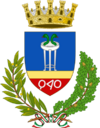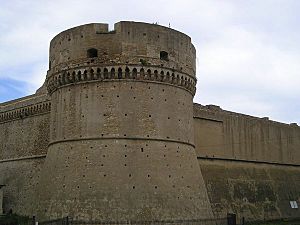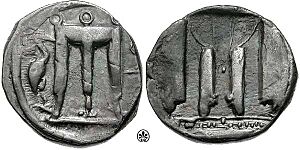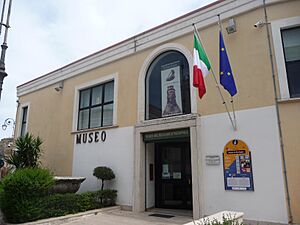Crotone facts for kids
Quick facts for kids
Crotone
Κρότων (Greek)
|
||
|---|---|---|
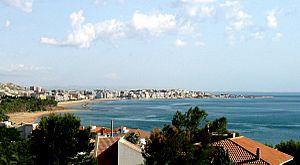
Panorama of Crotone
|
||
|
||
| Country | Italy | |
| Region | Calabria | |
| Province | Crotone (KR) | |
| Frazioni | Papanice, Apriglianello, Carpentieri, Cipolla, Farina, Gabella Grande, Iannello, Maiorano, Margherita | |
| Area | ||
| • Total | 179.8 km2 (69.4 sq mi) | |
| Elevation | 8 m (26 ft) | |
| Time zone | UTC+1 (CET) | |
| • Summer (DST) | UTC+2 (CEST) | |
| Postal code |
88900
|
|
| Dialing code | 0962 | |
| Patron saint | Dionysius the Areopagite | |
| Saint day | October 9 | |
Crotone is a city and comune (a type of municipality) in Calabria, Italy. It was founded around 710 BC as a Greek colony called Kroton. This city became a very important center of Magna Graecia, which was the name for the coastal areas of Southern Italy settled by ancient Greeks.
Crotone was home to famous people like the mathematician and philosopher Pythagoras. From the Middle Ages until 1928, it was known as Cotrone. In 1992, it became the capital of the new Province of Crotone.
Contents
History of Crotone
The area where Crotone is located was first settled by local groups during the Bronze and early Iron Ages.
How Crotone Was Founded
The founder of Kroton was Myscellus, who came from a city called Rhypes in Greece. He was told by the Delphic Oracle (a famous ancient Greek prophetess) to "Cross the vast sea and next to the Esaro (river) you will found Kroton."
The Greeks wanted to find new lands because their own mountainous region didn't have enough farmland. They also had a growing population. Myscellus likely made a few trips before finally establishing Kroton around 708 BC.
Archaeological finds show that when the Greeks arrived, they changed how local communities were organized. Many older settlements disappeared. Evidence from ancient graves suggests that Greeks and local women often married, right from the first generation of settlers.
The Greek Era
Kroton quickly grew into one of the most successful cities in Magna Graecia. Around 500 BC, its population was between 50,000 and 80,000 people. Early on, Kroton expanded its power across the Bruttian peninsula.
However, a defeat by Locri and Rhegium in the battle of the Sagra around 550 BC stopped Kroton's expansion. The city walls were very long, about 12 miles, enclosing a huge area.
The people of Kroton were known for their strength and simple way of life. From 588 BC, many Olympic champions came from Kroton. The most famous was Milo of Croton, a legendary wrestler. Kroton's doctors were also considered the best among the Greeks. One famous doctor, Democedes, even treated King Darius of Persia.
Kroton joined forces with Sybaris against another city called Siris. After a war around 550 BC, Siris was destroyed.
Pythagoras started his famous school in Kroton around 530 BC. His students included Alcmaeon of Croton, a medical thinker, and Philolaus, a philosopher and astronomer. The Pythagoreans became very influential in the city's government.
Sybaris became a rival to Kroton. The Pythagoreans, who disliked luxury, were against Sybaris. Around 510 BC, Sybaris had political problems, and a tyrant named Telys took over. Many rich people from Sybaris fled to Kroton. When Telys demanded they be returned, Kroton refused, leading to war. Kroton sent a huge army of 100,000 men, led by the wrestler Milo, and destroyed Sybaris. After this victory, Kroton became the leader of a group of 25 city-states.
In 480 BC, Kroton showed its support for the Greeks during the Battle of Salamis. Phayllos of Croton, a famous athlete, sent a ship at his own cost to help. This was the only ship from the Italian coast.
Soon after, a revolt led by Cylon of Croton caused many Pythagoreans to be killed or forced to flee. Pythagoras himself had to leave. This led to a period of decline for Kroton.
Later, the Italiote league was formed to protect cities from Syracuse and the Lucanians. Kroton was the leader of this league. Their meeting place was the Sanctuary of Hera Lacinia, which also served as the league's treasury.
In 379 BC, Dionysius, the ruler of Syracuse, captured Kroton and held it for twelve years. Later, the Bruttii occupied Kroton.
In 295 BC, another Syracusan ruler, Agathocles, took over Kroton. When Pyrrhus invaded Italy (280–275 BC), Kroton was still a large city. However, after the Pyrrhic War, half the town was empty.
The Roman Era
In 277 BC, the remaining people of Kroton surrendered to Rome. During the Second Punic War (216 BC), Kroton was given to the Brutii by a local leader who then joined the Romans. Hannibal used Crotone as his winter base for three years. The city was finally recaptured by Rome in 205 or 204 BC after the Battles of Croton.
In 194 BC, Rome established a new Roman colony there. Not much more is known about Crotone during the Roman Republic and Imperial times.
After the Roman Empire
Around 550 AD, the city was attacked by Totila, king of the Ostrogoths, but they failed to capture it. Later, Crotone became part of the Byzantine Empire. Around 841, the Republic of Venice sent a large fleet to help the Byzantines fight off the Arabs, but they were unsuccessful.
Around 870, the city was sacked by the Saracens. They killed the bishop and many people who had hidden in the cathedral, but they couldn't fully take over the city. More than a hundred years later, Otto II, Holy Roman Emperor, tried to reduce the power of the Byzantines in southern Italy. Crotone was later conquered by the Normans.
In 1806, the British occupied and looted Crotone, followed by the French. After that, it became part of the Kingdom of Naples. The 16th-century castle of Charles V, which you can still see today, reminds us of the time when Spain ruled. The Kingdom of the Two Sicilies (which included Crotone) was conquered in 1860 and became part of the new Kingdom of Italy in 1861.
Modern Crotone
Crotone's location between the ports of Taranto and Messina, and its access to hydroelectric power, helped it grow industrially between the two World Wars. In the 1930s, its population doubled.
However, by the late 1980s, Crotone faced an economic crisis. Two major companies closed, causing many people to lose their jobs and move away. In 1996, the Esaro river flooded the city, which was another big challenge. Since then, the city has been rebuilt and improved, making it a better place to live.
Archaeology
Archaeologists have learned a lot about ancient Kroton in recent years.
The City Walls
Experts have been able to map out the ancient walls of Kroton. They stretched from St. Lucia hill to Carrara hill, then north-west towards Cimone Rapignese, and even crossed the Esaro river. Parts of the wall found on St. Lucia hill show that it was rebuilt after a siege by Dionysius. The archaeological findings suggest the city covered at least 617 hectares.
Sections of the wall near the river were found in 1978. Other important parts were found on the "Vigna Nuova" hill and in the industrial area. A large piece of wall from the mid-4th century BC was found there, built with strong stone blocks.
Excavations since 1975 have helped complete the map of the Hellenistic walls, extending up Battery hill and down towards the sea.
City Excavations
Digs since 1975 have greatly increased our knowledge of the ancient city. Because modern Crotone is built on top of the old city, archaeological work can be challenging. However, the findings suggest that the entire walled area was occupied by closely built neighborhoods. These areas were between the Castle hill and Battery hill, and north of the Esaro river.
Archaeologists have found evidence of the city's layout from the late 7th and early 6th centuries BC. They've identified three large city blocks with a grid of narrow streets and paths between houses. Many houses have been excavated, including homes and workshops for artisans. They also found kilns and shops that made pottery. Ancient burial sites from the Hellenistic period have also been discovered. The building methods were simple and practical, using rough-cut stones. To protect the lower parts of the walls from rain, they used tiles or pieces of large pottery vessels.
Recently, a larger excavation was possible before a new school was built in Acquabona di Crotone. This revealed two narrow streets, about 5 meters wide.
In 2010, a building from the Roman Republic era was found. This suggests that the Roman colony might have been located on the acropolis (the highest part of the city). The building had painted walls in the Pompeian style and tiled and marble floors.
An important Roman house (domus) found in Discesa Fosso included baths. This shows there was a Roman "neighborhood" that was likely very fancy and secluded. It seems this house even had a small private port. This might be the port mentioned by Cicero, which helps us understand where the Roman colony was built in relation to the Greek city.
Geography
Climate
Crotone has a Mediterranean climate, which means it has hot, dry summers and mild, wet winters.
| Climate data for Crotone Airport | |||||||||||||
|---|---|---|---|---|---|---|---|---|---|---|---|---|---|
| Month | Jan | Feb | Mar | Apr | May | Jun | Jul | Aug | Sep | Oct | Nov | Dec | Year |
| Record high °C (°F) | 21.0 (69.8) |
22.0 (71.6) |
25.2 (77.4) |
26.2 (79.2) |
33.0 (91.4) |
43.0 (109.4) |
42.2 (108.0) |
42.0 (107.6) |
38.6 (101.5) |
31.8 (89.2) |
25.4 (77.7) |
22.4 (72.3) |
43.0 (109.4) |
| Mean daily maximum °C (°F) | 12.9 (55.2) |
13.0 (55.4) |
14.9 (58.8) |
17.4 (63.3) |
22.6 (72.7) |
27.5 (81.5) |
30.6 (87.1) |
30.4 (86.7) |
26.6 (79.9) |
21.6 (70.9) |
16.9 (62.4) |
13.8 (56.8) |
20.7 (69.2) |
| Daily mean °C (°F) | 9.2 (48.6) |
9.2 (48.6) |
10.8 (51.4) |
12.9 (55.2) |
17.4 (63.3) |
21.8 (71.2) |
25.0 (77.0) |
25.1 (77.2) |
21.9 (71.4) |
17.7 (63.9) |
13.3 (55.9) |
10.3 (50.5) |
16.2 (61.2) |
| Mean daily minimum °C (°F) | 5.6 (42.1) |
5.5 (41.9) |
6.7 (44.1) |
8.4 (47.1) |
12.2 (54.0) |
16.1 (61.0) |
19.4 (66.9) |
19.9 (67.8) |
17.2 (63.0) |
13.8 (56.8) |
9.6 (49.3) |
6.7 (44.1) |
11.8 (53.2) |
| Record low °C (°F) | −6.2 (20.8) |
−2.8 (27.0) |
−1.6 (29.1) |
0.8 (33.4) |
3.6 (38.5) |
8.2 (46.8) |
10.0 (50.0) |
11.6 (52.9) |
9.0 (48.2) |
4.0 (39.2) |
1.0 (33.8) |
−1.4 (29.5) |
−6.2 (20.8) |
| Average precipitation mm (inches) | 96.2 (3.79) |
87.1 (3.43) |
94.1 (3.70) |
52.7 (2.07) |
24.7 (0.97) |
5.2 (0.20) |
11.9 (0.47) |
24.0 (0.94) |
53.9 (2.12) |
115.8 (4.56) |
116.2 (4.57) |
109.8 (4.32) |
791.6 (31.14) |
| Average precipitation days (≥ 1 mm) | 8.0 | 7.4 | 7.0 | 5.8 | 4.0 | 1.3 | 1.1 | 2.2 | 3.8 | 6.5 | 7.4 | 8.5 | 63 |
| Average relative humidity (%) | 75 | 73 | 72 | 72 | 68 | 62 | 57 | 62 | 64 | 74 | 78 | 75 | 69 |
| Mean monthly sunshine hours | 130.2 | 138.3 | 170.5 | 195.0 | 251.1 | 279.0 | 313.1 | 291.4 | 231.0 | 189.1 | 144.0 | 117.8 | 2,450.5 |
| Source 1: Servizio Meteorologico (1971–2000 data) | |||||||||||||
| Source 2: Servizio Meteorologico (1961–1990 data on humidity and sunshine) | |||||||||||||
Main Sights in Crotone
- The Cathedral was first built between the 9th and 11th centuries. It has been rebuilt many times. It features a neo-classical front and a Baroque-style inside. Look for a baptismal font from the 12th century and the Madonna di Capo Colonna, a famous Black Madonna statue.
- The Castle of Charles V from the 16th century is a must-see. It now holds the Town Museum, with items found from ancient Croton. You can also see parts of the old city walls and watchtowers from the same time period.
- The ancient castle on an island, called Le Castella, can only be reached by walking across a narrow strip of land.
| Historical population | ||
|---|---|---|
| Year | Pop. | ±% |
| 1861 | 5,945 | — |
| 1871 | 7,100 | +19.4% |
| 1881 | 8,642 | +21.7% |
| 1901 | 9,545 | +10.4% |
| 1911 | 10,162 | +6.5% |
| 1921 | 11,600 | +14.2% |
| 1931 | 18,721 | +61.4% |
| 1936 | 21,496 | +14.8% |
| 1951 | 31,928 | +48.5% |
| 1961 | 43,256 | +35.5% |
| 1971 | 50,970 | +17.8% |
| 1981 | 58,262 | +14.3% |
| 1991 | 59,001 | +1.3% |
| 2001 | 60,010 | +1.7% |
| 2011 | 58,881 | −1.9% |
| 2021 | 59,359 | +0.8% |
| Source: ISTAT | ||
Transportation
Crotone Airport (Sant'Anna Airport) serves Crotone with flights from various airlines. Crotone also has a railway station. Most visitors arrive by car using the Salerno-Reggio Calabria highway or the National Road 106 Ionica, which runs along the eastern coast. Recently, the Crotone Port has become popular for people on yacht charter (renting a boat for a vacation) trips.
Culture
Museums in Crotone
Crotone has several museums, including a national archaeological museum, a municipal museum, an art gallery, and a contemporary art museum. There's also the Antiquarium di Torre Nao.
- The National Archaeological Museum opened in 1968. It's in the historic city center and displays important finds from archaeological sites across the Crotone area. Many valuable items come from the Sanctuary of Hera Lacinia site in Capo Colonna.
Sports in Crotone
F.C. Crotone is a football (soccer) club that plays in Serie C. The team reached Italy's top league, Serie A, for the first time in the 2016–17 season. After a year in Serie B, they were promoted again for the 2020–21 season.
Achei Crotone is an American football club that plays in Italy's 3rd division. It was started in 1989 and is known as one of Italy's most historic teams.
Churches in Crotone
- The Church of the Immaculate Conception was originally built in the 9th century. It was first dedicated to St. Dionysius, then later to the Assumption of Saint Mary. Over the centuries, it has been restored many times. In the 16th century, a bishop rebuilt it using materials from the ancient temple of Hera Lacinia. Inside, the church has three main sections divided by pillars.
- The Cathedral was built in 1686 on the site of an old chapel. It was dedicated to the Blessed Virgin Mary by a group of local people. The front of the church has a simple and grand neoclassical style. It features a main entrance with a single arch, a stained glass window of the Virgin, and two niches with statues.
Notable People from Crotone
Many famous people have come from Crotone, especially athletes and thinkers from ancient times:
- Milo of Croton (6th century BCE), a legendary Olympic athlete.
- Dameas of Croton, a sculptor who made a statue of Milo.
- Phayllos of Croton, an Olympic athlete and war hero.
- Astylos of Croton (5th century BCE), an Olympic athlete.
- Democedes of Croton (6th century BCE), a famous physician.
- Alcmaeon of Croton (5th century BCE), a philosopher and medical theorist.
- Philolaus of Croton (5th century BCE), a Pythagorean philosopher.
- Pythagoras, the famous mathematician and philosopher, lived in Crotone around 530 BCE.
- Rino Gaetano, a modern singer, was born in Crotone.
- Vincenzo Iaquinta, a footballer, was born in Crotone.
International Relations
Twin Towns – Sister Cities
Crotone is twinned with:
Images for kids
See also
 In Spanish: Crotona para niños
In Spanish: Crotona para niños


